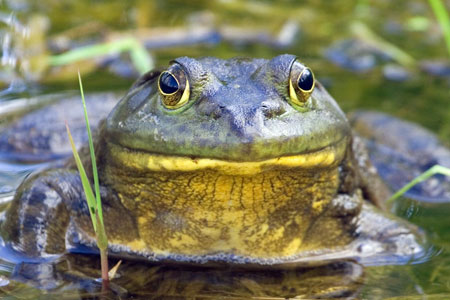
Home | About Us | How to Participate | Biodiversity Modules | Projects | Maps | News | Resources

Home | About Us | How to Participate | Biodiversity Modules | Projects | Maps | News | Resources

American Bullfrog (Rana catesbeiana)
Description:
Bullfrogs are typically green or greenish brown, and can be a light or dark shade. The back and sides may be plain or may have dark spots.
The arms and legs are spotted or barred with dark. Underparts are white, distinctly or obscurely spotted and mottled.
Both male and female bullfrogs can reach a body length of 6 to 8 inches. Females are typically larger than males. Bullfrogs weigh up to 750 grams (1.7 lb). A bullfrog's head is broad and flat, with a large mouth. The common bullfrog is a powerful swimmer, with strong, long back legs that may measure from seven to ten inches and having very large webbed feet. Range/ Habitat: Bullfrogs range naturally from the eastern to central U.S., north to Nova Scotia, and south to Mexico. The American Bullfrog was introduced to the Pacific Northwest in the late 1920s or early 1930s as a food source. They have big, meaty legs, which are said to be low in calories and fat and highly nutritious. In the last 70 years, the bullfrog has greatly expanded its range. It is larger than native frogs and, in some areas, may have displaced them. In Washington, this frog is commonly found in many lakes, reservoirs and sloughs. It is highly aquatic and stays close to the borders of lakes. Its spread throughout Washington State may be due more to illegal releases and floral nursery sales for insect control that its ability to spread on its own.

Diet: Carnivore. They like to eat crayfish, water beetles, snails and dragonfly larvae. The also eat fish, small turtles, young water birds, and even other frogs! Reproduction: The bullfrog is generally a solitary animal except during breeding season which runs from late May into July. Adult Bullfrogs gather at breeding ponds in early summer, much later than most native frog species. Males stake out territories with good egg-laying sites and defend them, calling loudly to attract females and chasing away rival males. After mating, females lay masses of up to 20,000 eggs in a film on the water’s surface. The bullfrog eggs hatch in four or five days (depending on temperature). Tadpoles hatch out in July and remain in the ponds through that summer and the following winter, metamorphosing in August or September of their second year. Behavior: Adult bullfrogs can generally leap about 1 meter (3 feet), but they are able to jump a distance of 2 meters (6 feet) without difficulty. Males produce loud calls to attract females and establish their territories. They are aggressive when defending their territory. Lifespan: Maximum lifespan in the wild is estimated at 8–10 years, but one captive lived almost 16 years.
Did you know?
More Information: Animal silhouettes available to purchase » Photo Credit: Natures Pics Home | About Us | How to Participate | Biodiversity Modules | Projects | Maps | News | Resources |